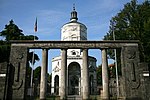Pusterla di Sant'Ambrogio (Milan)

The Pusterla di Sant’Ambrogio (Saint Ambrose postern in English) was originally built in 1171 after the city was destroyed by Frederik I Barbarossa in 1162. This postern was one of the ten secondary gates of Milan medieval walls. When in the 16th century the new set of city walls went up (under the Spanish domination of the city), the Pusterla of Saint Ambrose was turned into a prison. In 1939 this postern was completely restored with the original features. The Pusterla di Sant’Ambrogio is sited near the Basilica of Sant'Ambrogio, one of the most ancient and important churches in Milan. Above the two arches of the door there is a tabernacle with Saint Ambrose, the patron of Milan, Saint Gervase and Saint Protase.
Excerpt from the Wikipedia article Pusterla di Sant'Ambrogio (Milan) (License: CC BY-SA 3.0, Authors, Images).Pusterla di Sant'Ambrogio (Milan)
Via San Vittore, Milan Municipio 1
Geographical coordinates (GPS) Address External links Nearby Places Show on map
Geographical coordinates (GPS)
| Latitude | Longitude |
|---|---|
| N 45.461944444444 ° | E 9.1738888888889 ° |
Address
Pusterla di Sant'Ambrogio
Via San Vittore
20123 Milan, Municipio 1
Lombardy, Italy
Open on Google Maps










